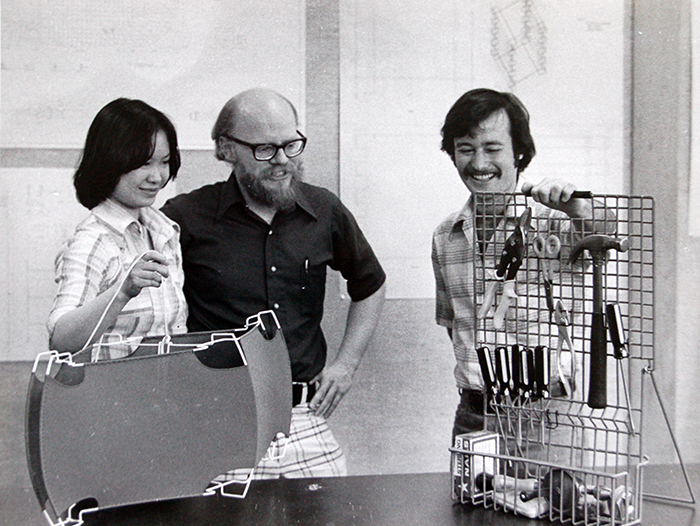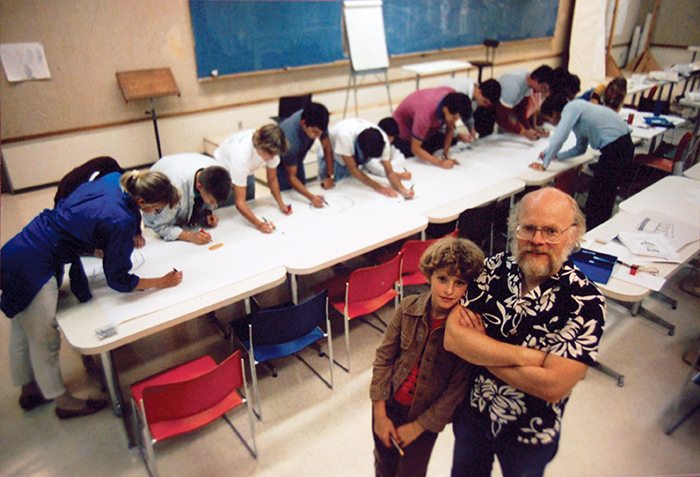|
|
Rolf A. Faste Foundation for Design Creativity |
About
|
|
||||||
|
|
|

Rolf brought humility and passion to his teaching, embodying creativity as a way of being. His teaching demonstrated the possibility of achieving personal clarity and wisdom by noticing how we feel, observing the needs of the people around us, and motivating action towards what matters most. This simple approach has guided generations of students in design and in life. Rolf was born in Seattle, Washington, the eldest child of Andreas Faste, a naval architect noted for his work on the MV Coho ferry, and Edith Morch Faste, an artist. Interested from a young age with the intersection between art and engineering, he earned a bachelor’s degree in mechanical engineering from Stevens Institute of Technology in 1965 and a master’s degree in engineering design from Tufts University in 1971. Faste’s graduate thesis work at Tufts on engineering creativity was advised by Percy H. Hill in collaboration with William J. J. Gordon, the originator of Synectics,1 and demonstrated a correlation between an individual’s creative ability when working on science and engineering problems and their capacity to visualize solution concepts.2 Rolf was a visual thinker, and came to believe he was dyslexic, which is highly unusual for engineering professors. His interest in visual thinking and education began a lifelong interest in creativity and its role in engineering and design. Rolf was a professor of Industrial Design at Syracuse University from 1971 – 1984, where he taught classes on rapid visualization, prototyping, materials, computer-aided design, aesthetics and the creative process. He was active in the field of accessible design in the early 1970s, and as research associate on the American National Standards Institute’s A117 project, he co-authored the national standards for accessibility to buildings that were adopted nationwide.3,4 During this time he also earned a third degree in architecture, from Syracuse University, in 1977. Faste traveled extensively as a designer during the 1970s, working on universal design projects touching transporation, international development, education, and civil rights, and served as UNESCO consultant to the Indian Institute of Technology in Bombay, India, in 1980.5 
Rolf Joined the faculty of mechanical engineering at Stanford University in 1984, replacing professor Bob McKim as director of the Design Program. (McKim had founded the program in the late 1950s, and was retiring.) At Stanford Rolf’s work was noted for his contributions to engineering education and design research, continuing McKim’s work in areas such as Needfinding and Visual Thinking, and developing new courses to strengthen student’s visual and creative skills including Ambidextrous Thinking, Expression of Function, Aesthetics of Machinery, and Calibrating the Instrument (i.e. the designer’s body and mind). Rolf was interested in exploring the way that the body and mind influence technical creativity, understanding needs and cultural meaning in the creation of products, and incorporating functional, aesthetic and humanistic concerns in design.6 He was a recipient of the Raymond J. Perrin Award for Teaching and Course Development, and held five patents and one patent pending for his innovations, mostly in the area of medical product development. Rolf also published many articles throughout his career that expanded on the topic of creativity in design education and practice. His work reflected on the role of perception in design, pattern recognition and synthesis, experiential design education, and the relationship between creativity and convention in business and design. In early 2003 Rolf was diagnosed with terminal cancer and given just a few weeks to live. The book on design he had been writing for the prior 10 years, Zengineering, remained unfinished, and he spent his last days at home with his family. Following Rolf’s passing his family, friends, students and colleagues gathered in Toyon Hall at Stanford University to share their memories in a celebration of his life. Documentation of that event is available here. Rolf’s life and work embodied optimism, selflessness, integrity, and compassion. He knew that design that is motivated from the heart and requires strength and balance when making uncomfortable creative leaps. In 2009 Rolf’s sons founded the Faste Foundation to advance the spirit of openness that infused his teaching and creative practice. We are dedicated to furthering Rolf’s vision of design as a way of being in the world for the betterment of human society and mind. 
References
|

|
|
|
|
|
Faste Foundation
|

|
Click here to join our mailing list.
|

|
